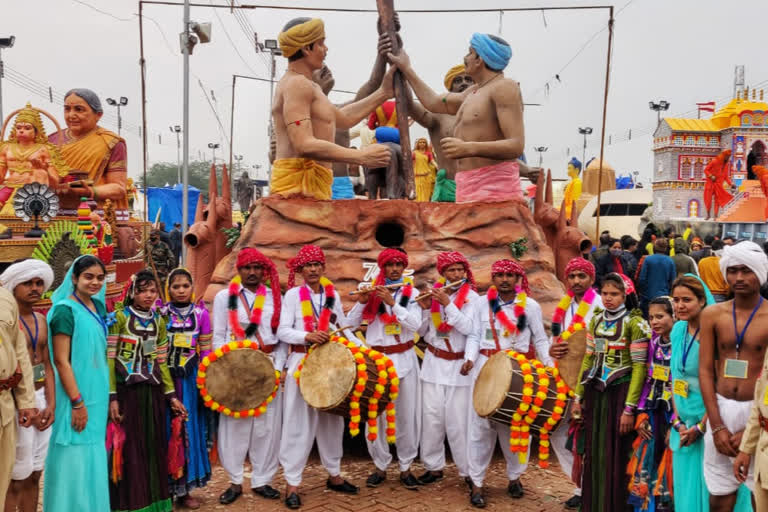Gandhinagar: Ahead of Republic Day celebrations, Gujarat will highlight the contribution of tribals in the freedom struggle through tableaux at the Republic Day Parade in New Delhi on January 26. Pal and Dadhwav villages of Sabarkantha district of north Gujarat, the British had committed a more horrific massacre than Jallianwala Bagh, in which about 1,200 tribals were martyred, and their sacrifices will be depicted in the tableau which is name as 'Gujarat's tribal revolutionaries'.
On the 100th anniversary of this unknown historical event, the Gujarat government will present the saga of the valour of the state's tribal community to the world through a tableau. The 45 feet long, 14 feet wide and 16 feet high tableau of Gujarat, to be presented at the Rajpath in New Delhi during the Republic Day parade, presents the incident of the British firing indiscriminately on the tribal revolutionaries of Pal-Dadhwav.
The seven feet tall statue of Motilal Tejawat, whom the tribals call the 'Gandhi of Koliyari', enhances the dignity of the tableau. The sculpture of HG Stern, an English equestrian on a horse, is also a gentle example of sculpture. There are also six other sculptures on the tableau. The tableau will also feature six live artists, who will clearly portray the gravity of the event with their live performances.
READ: Karanataka tableau selected for Republic Day Parade
There are five murals around the tableau. In a wonderful combination of sculpture and painting, this mural effectively presents the scenes of the gathering of tribal revolutionaries. There are two wells on either side of the tableau, Dhekhliyo Kuwo and Dudhio Kuwo, in which the corpses of the martyred tribals are depicted. In front of the tableau are statues of four tribal revolutionaries with torches in their hands. The four feet tall statue depicts the bravery, courage and dedication of the tribals in the freedom struggle. The tribals in this area of Sabarkantha district offer earthen horses to the Lord. These horses are the identity of the Sabarkantha district. Two such horses are presented on either side of the table.
Along with the tableau, tribal artistes from Sabarkantha district will perform traditional Ger-Nrutya (Traditional Dance) in New Delhi. Dressed in traditional costumes, these 10 tribal artistes belong to Poshi Taluka. They will also contribute in the presentation of this unprecedented event of the sacrifice of their ancestors. A musical track composed by musicians and singers of the Sabarkantha district will be presented, along with traditional instruments. Tribal artistes will perform Ger-Nrutya with this music. Not only this, songs narrating the heroic tales of the tribals of Pal-Dadhwav are still sung by the tribals of this region in folklore on weddings and auspicious occasions in memory of their heroic ancestors. A song is sung in the local language by the tribals addressing Motilal Tejawat as 'Gandhi of Koliyari' will also be presented.
About 600 innocent civilians were killed at Jallianwala Bagh in Amritsar, Punjab on April 13, 1919. Later in 1920, Gandhiji started the non-cooperation movement in Calcutta. The freedom struggle had started all over the country. In the Sabarkantha district of Gujarat, the Bhil tribals, who lived a lavish life in the Aravalli hills, also protested the exploitation, harsh taxes and tyranny of the British and the feudal lords.
ALSO READ: Wrong precedent to criticise Centre for states' tableaux exclusion: Govt sources
Freedom-loving tribals met under the leadership of Motilal Tejawat, known as the Gandhi of Koliyari. An armed military force of the British paramilitary force called Mewar Bhil Corps (MBC) was stationed on the Jaramara hills. Major HG Stern, the British officer of the MBC, ordered to shoot at the thousands of tribals, who had gathered, and around 1,200 innocent tribals were shot dead.
The sound of gunshots from machine guns erased the dance and drums of the tribals forever. There were piles of dead bodies everywhere. Like a battlefield, the whole field was filled with corpses. The nearby Dhekhaliya Kuwa and Dudhio Kuwa were filled with the bodies of around 1,200 innocent tribals. Motilal Tejawat was also shot twice. Later, his companions made him sit on a camel and took him to the hills along the river. The tribals of this region still sing songs of this event in their wedding songs. History has forgotten this horrific incident in the Sabarkantha district of Gujarat, which took place three years after the Jallianwala Bagh massacre. But when Prime Minister Narendra Modi was at the helm as the Chief Minister of Gujarat, he had promised to bring out this history in front of the world. The Shaheed Smriti Van and the Shaheed Smarak in this area today were built in memory of the martyrs.



